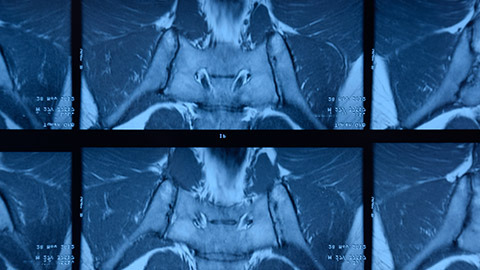04/29/2022

The Rebel Massage Therapist wrote in with one of her “I Have a Client Who . . .” stories in this episode about a client with textbook-defying symptoms. Listen for an exploration of ankylosing spondylitis, and what surprising findings we see in the research about massage for this condition.
Resources:
Pocket Pathology: https://www.abmp.com/abmp-pocket-pathology-app
Abbood, H.M., Pathan, E. and Cherukara, G.P. (2018) ‘The link between ankylosing spondylitis and oral health conditions: two nested case-control studies using data of the UK Biobank’, Journal of Applied Oral Science, 27, p. e20180207. doi:10.1590/1678-7757-2018-0207.
Abilash, K. et al. (2017) ‘Fracture-dislocation at C6-C7 level with Quadriplegia after Traditional Massage in a Patient with Ankylosing Spondylitis: A Case Report’, Malaysian Orthopaedic Journal, 11(2), pp. 75–77. doi:10.5704/MOJ.1707.013.
Ankylosing Spondylitis in Females (2021) Healthline. Available at: https://www.healthline.com/health/ankylosing-spondylitis-men-and-women (Accessed: 27 April 2022).
‘Ankylosing Spondylitis in Women: 8 Key Facts to Stop the Stigma’ (2019) CreakyJoints, 29 March. Available at: https://creakyjoints.org/about-arthritis/axial-spondyloarthritis/axspa-overview/ankylosing-spondylitis-in-women/ (Accessed: 27 April 2022).
Ankylosing spondylitis in women: Prevalence, symptoms, and more (2021). Available at: https://www.medicalnewstoday.com/articles/ankylosing-spondylitis-women (Accessed: 27 April 2022).
‘Does the Microbiome Cause Ankylosing Spondylitis?’ (no date) Spondylitis Association of America - Ankylosing Spondylitis. Available at: https://spondylitis.org/spondylitis-plus/does-the-microbiome-cause-ankylosing-spondylitis/ (Accessed: 27 April 2022).
Romanowski, M.W. et al. (2017) ‘Comparison of Deep Tissue Massage and Therapeutic Massage for Lower Back Pain, Disease Activity, and Functional Capacity of Ankylosing Spondylitis Patients: A Randomized Clinical Pilot Study’, Evidence-based Complementary and Alternative Medicine : eCAM, 2017, p. 9894128. doi:10.1155/2017/9894128.
Zou, G. et al. (2017) ‘Danger of injudicious use of tui-na therapy in ankylosing spondylitis’, European Spine Journal: Official Publication of the European Spine Society, the European Spinal Deformity Society, and the European Section of the Cervical Spine Research Society, 26(Suppl 1), pp. 178–180. doi:10.1007/s00586-017-5002-1.
Image of Spondylitis Ankylosans


This podcast sponsored by:
Books of Discovery: www.booksofdiscovery.com
Anatomy Trains: www.anatomytrains.com
About Anatomy Trains:
Anatomy Trains is a global leader in online anatomy education and also provides in-classroom certification programs for structural integration in the US, Canada, Australia, Europe, Japan, and China, as well as fresh-tissue cadaver dissection labs and weekend courses. The work of Anatomy Trains originated with founder Tom Myers, who mapped the human body into 13 myofascial meridians in his original book, currently in its fourth edition and translated into 12 languages. The principles of Anatomy Trains are used by osteopaths, physical therapists, bodyworkers, massage therapists, personal trainers, yoga, Pilates, Gyrotonics, and other body-minded manual therapists and movement professionals. Anatomy Trains inspires these practitioners to work with holistic anatomy in treating system-wide patterns to provide improved client outcomes in terms of structure and function.
Website: anatomytrains.com
Email: info@anatomytrains.com
Facebook: facebook.com/AnatomyTrains
Instagram: www.instagram.com/anatomytrainsofficial
YouTube: https://www.youtube.com/channel/UC2g6TOEFrX4b-CigknssKHA
0:00:01.2 Ruth Werner: Hey, I Have a Client Who listeners, did you know I have a growing library of NCB approved one-hour online self-paced continuing education courses that you can do any time, anywhere? Well, now you know. Current classes include; What's Next? Covid-19 updates for massage therapists and A Massage Therapist's Introduction to Pharmacology Part One, and brand new, A Massage Therapist's Introduction to Pharmacology Part Two. Classes are $20 each and they confer one hour of continuing education credit. Wanna know more? Visit my website at ruthwerner.com and check it out. Be sure to sign up for my mailing list so you'll never miss a new class.
0:00:47.6 Speaker 2: Anatomy Trains is delighted to invite you to our in-person fascial dissection workshop, May 30th through June 3rd, 2022. We're excited to be back in the lab with Anatomy Trains author Tom Myers and master dissector, Todd Garcia in Todd's laboratory of anatomical enlightenment in Boulder, Colorado. Join students from around the world and from all types of manual movement and fitness professions to explore the real human form, not the images you get from books. Visit anatomytrains.com for details.
0:01:34.2 RW: Hi, and welcome to I Have a Client Who, pathology conversations with Ruth Werner, the podcast where I will discuss your real life stories about clients with conditions that are perplexing or confusing. I'm Ruth Warner, author of A Massage Therapist's Guide to Pathology, and I have spent decades studying, writing about and teaching about where massage therapy intersects with diseases and conditions that might limit our client's health. We almost always have something good to offer, even with our most challenged clients, but we need to figure out a way to do that safely, effectively and within our scope of practice, and sometimes, as we have all learned, that is harder than it looks.
0:02:20.2 RW: Today's I Have a Client Who story comes from my podcast sister, The Rebel massage therapist herself, Allison Denney, who gave me permission to share her name, and this fascinating tale. She wrote, my client has ankylosing spondylitis. This was not something I'd had a lot of experience with, so I did a little... Okay, a lot of research. She's around 50 years old, two teenage kids, and in general, she leads a healthy life style, lots of walks, doesn't drink much and so on. Her symptoms came on in spurts and felt disconnected, she had plantar fasciitis and bone spurs in her left foot, her limbs occasionally became inflamed and swollen, and she had a toothache, which turned out to be a loose tooth, which eventually fell out. Her pain began to increase as her energy fell and she began having weird reactions to foods that she had previously had no issues with. She ended up spending an entire week at the Mayo Clinic in Minnesota where they diagnosed her with ankylosing spondylitis and connected it to psoriatic arthritis. I think there's a difference between the two, but they are closely related, and I believe both played a role in my client's condition.
0:03:37.6 RW: I knew this all fell under the umbrella of an autoimmune disorder, so I have played around with different techniques like lymphatic drainage and light compressions and bolstering options for when she's on the table. Receiving massage offers her the most relief, but she continues to struggle. Well, this is a fascinating story for several reasons, which we'll get into in a moment. Before we dive into ankylosing spondylitis, let's just say a few words about autoimmune diseases. When I ask live classes what an autoimmune disease is, someone almost always has something like the body attacks itself. Well, that's a gesture in the right direction, but it's not quite correct, what happens in autoimmune diseases is that the immune system makes a mistake and begins to attack various parts of the body as though those cells or tissues were dangerous invaders. We actually talked about this a couple of weeks ago with the episode on lupus. Ankylosing spondylitis or AS, and psoriasis and psoriatic arthritis are all versions of autoimmune diseases, and they are part of a group called seronegative autoimmune diseases, because they don't involve a blood marker called anti-nuclear antibodies or ANA. Crohn's disease and ulcerative colitis are also in this group, and all of these do often overlap in the same people or in the same family.
0:05:07.7 RW: However, this client is a little unusual because unlike most autoimmune diseases, AS is more common among men than it is among women by a ratio of about 3:1. So to have a woman with ankylosing spondylitis, which is not super common to begin with, is especially rare, and this client's presentation with ankylosing spondylitis is really surprising and not at all like a typical case, which goes to show why it's a good thing we don't rely on textbooks to make diagnoses. As always, we will start our discussion of ankylosing spondylitis by taking apart that term. Spondylitis, you probably get, inflammation of the spine. But for some people who maybe didn't raise a dinosaur obsessed child, ankylosing might be more obscure. There was a dinosaur called Ankylosaurus, which is how I learned that this word comes from both Latin and Greek word roots, that means stiff, bent joints. So ankylosing spondylitis means spine inflammation with bent, stiff joints. And in the most typical presentations, this is exactly what happens. This progressive autoimmune inflammatory attack on spinal joints usually starts at the sacroiliac joints and then moves up the spine causing vertebrae to fuse often in a bent over or twisted or otherwise distorted position. And when I say fused, I mean really fused.
0:06:42.7 RW: There's an X-ray sign called bamboo spine that's used to describe someone who has AS, the vertebral bodies join into a single bone that looks like a fixed stalk of bamboo. I'll put a couple of Wikimedia pictures in our show notes for today to demonstrate what I mean by this. AS is a potentially dangerous disease because it can cause the spine to curve over in this really extreme flexion, it can make the ribs fused to the spine, so they don't expand and contract with breathing, that is a recipe for life-threatening pneumonia, other complications of ankylosing spondylitis range from not a big deal to really serious. Some people get irritated, itchy eyes, this is iritis during flares. Some patients get swollen hand joints and fingers, we see this with psoriatic arthritis too, and some patients, especially women have painful inflamed peripheral joints like shoulders and hips, and we heard a hint of that in our client's description. Lots of people with AS also develop osteoporosis with a high risk of spinal fractures and they may also develop heart failure because of limited space in the thoracic cavity. Ankylosing spondylitis is often, but not always linked to the presence of a particular gene called HLA-B27.
0:08:05.6 RW: Having this gene radically increases the chance of a person developing ankylosing spondylitis but not everyone who has HLA-B27 gets AS. We don't know what other things might cause AS other than this genetic predisposition, but we do see some interesting differences in the gut microbiomes of people who have this condition, which is especially intriguing in light of this client developing those weird reactions to foods that she had never had an issue with or maybe her digestive upset might hint at some crossover with inflammatory bowel disease, that's Crohn's disease or ulcerative colitis. The exact links between AS and the gut microbiome are still being explored, but there are some hints in rat models that this might open some new options for treatment and that would be amazing. The statistics say that men are diagnosed with AS about three times more often than women, however, this might be because the disease presentation and progression that I have described here with that progressive inflammatory arthritis that moves up the spine, that is seen most often in men. Women with AS may present milder symptoms that vary from this model. We have relied on X-rays to show changes in bone structure, but this process happens more slowly in women.
0:09:32.2 RW: There's a great name for this; Non-radiographic axial spondyloarthritis, that means damage at the spine but it doesn't show up on x-rays. The use of MRIs now show some subtler symptoms and earlier in the process, especially when they're targeted at the sacroiliac joints and not just the lumbar spine, but still ankylosing spondylitis in women is often missed in its early stages, and that means women are likely to be at a more advanced stage of the disease when they are diagnosed with a higher burden of tissue damage, a large systematic review showed that it takes women about two years longer to be correctly diagnosed with AS compared to men. Most resources say that the signs and symptoms of ankylosing spondylitis are more or less the same for men and women, especially with the experience of low back pain, which we didn't hear about in the description of our client, but that might be implied. Women are also more likely to have joint pain elsewhere like the neck or the shoulders, the most common signs and symptoms include dull pain and stiffness in the low back and SI joints, back pain that's often unilateral, and this pain tends to be worse after rest, but then it subsides with movement and exercise, some people have a low-grade fever, especially during flare, and they might experience a loss of appetite and a loss of energy. As the disease progresses, we can expect to see bilateral pain and stiffness in the neck, ribs, shoulders, hips and heels.
0:11:10.4 RW: Remember our client's plantar fasciitis? I wonder if this is part of that. Also increased fatigue and maybe anemia, that's something we often see with autoimmune diseases. Notice there's nothing in this list about tooth loss, but I did a little Googling and guess what? I found a study that did find associations between ankylosing spondylitis and an increased risk for periodontal disease, which can lead to tooth loss. What treatment options are available for people with AS? Well, we look for physical therapy and possibly massage therapy and exercise to keep joints as mobile and healthy as possible. NSAIDs, those non-steroidal anti-inflammatory drugs might be enough to manage pain, but many patients go on to use a variety of medications that impact immune system activity, these might include DMARDs, disease-modifying antirheumatic drugs and TNF inhibitors and IL-17 inhibitors. TNF and IL-17 are pro-inflammatory cytokines. If we can inhibit them, then we interfere with inflammation and these tend to work pretty well. But what about massage? There's not a lot of data on this. However, I did find one tantalizing small clinical trial out of Poland that compared therapeutic massage to deep tissue massage.
0:12:36.2 RW: I know, I know, I hate that term too, but at least they had pretty full descriptions of what these two protocols involved, and they used these on a group of 27 men diagnosed with ankylosing spondylitis. Not surprisingly, both groups had improvement in pain and some other measures. However, the deep tissue group had a greater improvement in pain than the therapeutic massage group, the point of the study was to suggest that massage could be a useful adjunct in the treatment of ankylosing spondylitis, especially since not a lot of other options are available. That said, it's important to point out that there are also a couple of case reports on manual therapies for people with advanced ankylosing spondylitis, where there had been fusions and bone weakness in the neck, and the therapists who went past those people's tolerance for range of motion ended up causing devastating injuries and permanent paralysis. Okay, so let's return to the lady in our story, here's a recap, she's around 50 years old, she has two teenage kids, she leads a healthy life with lots of walking and she doesn't drink much and so on, she has a history of disconnected symptoms including plantar fasciitis and inflamed limbs and this tooth loss, her pain began to increase as her energy fell and she started having weird reactions to foods.
0:13:58.4 RW: After a week at the Mayo Clinic, they diagnosed her with ankylosing spondylitis and psoriatic arthritis. And this massage therapist feels this all falls under the umbrella of autoimmune disorder, so she's played around with some different techniques like lymphatic drainage and light compressions and bolstering options for when the client is on the table. It seems clear to me that we're not getting this client's whole symptomatic profile here, but we also have to bear in mind that diseases and conditions, especially autoimmune ones often don't follow the textbooks. This client was wise and lucky to get to the Mayo Clinic for a full work up so that she can do what is possible to slow the progress of this condition.
0:14:43.2 RW: I especially appreciate Allison's emphasis on bolstering. Remember, these clients may have spinal joints that are swollen and a bit distorted and they may benefit from extra external support. In terms of the intensity of Allison's work, for me, that might depend on how the client is feeling, if she's in flare or feeling puny, then gentler work is absolutely appropriate, but otherwise, remember our deep tissue clinical trial, it seems to me that as long as the work is pain-free and within the client's tolerance for range of motion and pressure, she might be able to benefit from massage that might be a little more challenging, it could be interesting to experiment a bit to see what she likes best, because maybe she's just really happy with the super gentle and super relaxing massage that she's getting from Allison. I wanna thank my podcast sister Allison Denney, The Rebel massage therapist for sending me this great I Have a Client Who story, and I wanna be sure to invite you to do the same.
0:15:43.6 RW: Hey everybody, thanks for listening to I Have a Client Who pathology conversations with Ruth Werner. Remember, you can send me your I have a Client Who stories to ihaveaclientwho@abmp.com. That's ihaveaclientwho, all one word, all lowercase @ABMP.COM. I can't wait to see what you send me and I'll see you next time.





